Here are some of my recent bakes: First off is Pane di Como from Daniel Leader's "Local Breads". This is basically a simple white loaf leavened with a biga. It's pretty wet and tricky to work with, and came across as a wicked hybrid of a plain country bread and a ciabatta dough. It's really wet according to my bread standards (73%), but I think it turned out alright. It turned into a flat, wet disc during the final proof, but the oven spring was nothing short of impressive. An interesting bread to bake, but I think I prefer Hamelman's country bread to this one.
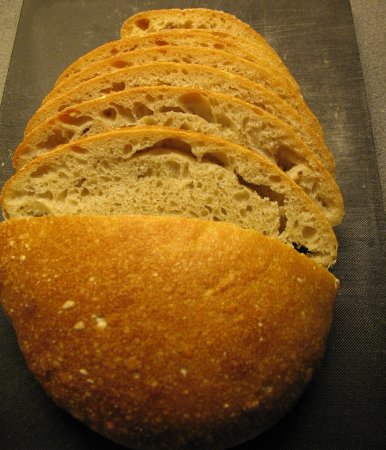
Leader's Pane di Como
Next is another batch of Suas' NY rye. Thanks again for posting the recipe, Howard; as you said, this is a keeper. Great taste, awesome caraway scent, and a joy to bake.
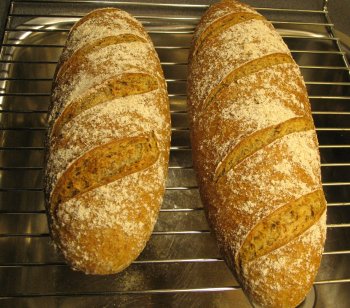
Suas' NY style rye
The caraway rye is a brilliant companion to gravlaks!
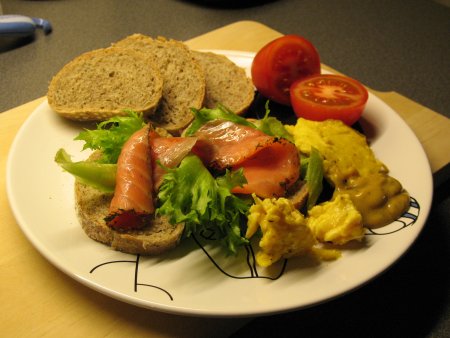
Suas' NY style rye and gravlaks
Lastly, here's my version of Eric and Mark's kalamata olive and cheese loaf. I made this with a pâte fermentée, and added feta cheese to the dough. There's roughly 10% rye flour in the dough.
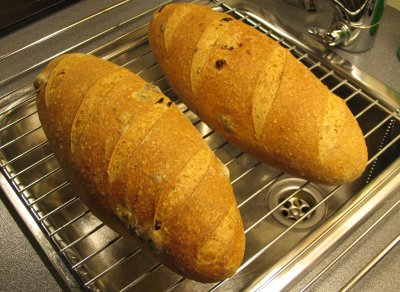
Kalamata olive and feta cheese loaves
The loaves were really tasty, but I'll cut back a little bit on the salt next time. I only added 1.5% salt to the overall dough recipe, but the olives were pretty salty as well. Great tasting bread, nevertheless. Thanks for the recipe Eric and Mark :-)
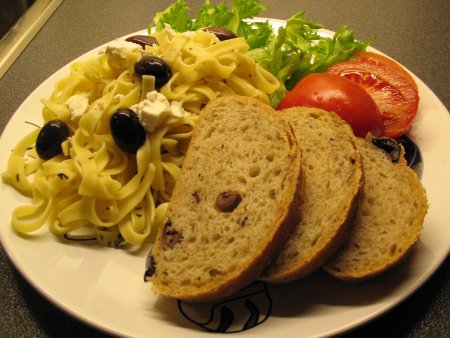
Kalamata olive and feta cheese loaf with pasta
- hansjoakim's Blog
- Log in or register to post comments
looks absolutely decadent! What else is on the plate (besides the L, T & bread?)
I also used feta with Mark's bread. I did not change the salt content, but was very careful to rinse the olives.
Very nice loaves,
Betty
Thanks Betty :-)
Yes, the gravlaks meal turned into a pretty tasty affair... Along with the fish and bread, I had a simple salad, some scrambled eggs (that's the yellow stuff on the plate - a really low key version, just some beaten eggs, a tablespoon each of water and butter, some salt, ground pepper and thyme), and a special gravlaks sauce, made of dijon mustard and vinegar (that's the brownish lump). You know, gravlaks sauce is to gravlaks as mozarella is to Neapolitan pizza: You can eat gravlaks without it, but many think it's not complete without a dash of mustard sauce. And it tastes great too, so there's no reason to skip it. This is really the time of the year in Norway to enjoy these kinds of cured fish.
I think the kalamata bread recipe is really well balanced, but I tried a different brand of kalamata olives this time, and they were more salty than the ones I'm used to. I'll take your advice, and carefully rinse them in my next batch. The smell of herbs and kalamata olives was nothing short of mouthwatering... :-)
Thanks again, Betty!
I don't know what grav laks are but it certainly looks delicious. Love you bread and pasta looks so fantastic. Your breads are awsome. Wonderful images...I hope to learn how to post some on this new site..
Sylvia
Thanks for the nice compliments, Sylvia!
Gravlaks is raw salmon that is cured in a mix of dill, sugar and salt. It packs a more hefty punch than ordinary smoked salmon :-)
I have a question for you - not sure you caught my recent thread "Bread Blues", but I've been through some major yeast grievances with pane di como.
Looking at your bread, I see that it turned out much better than mine, of course - but it is not like the book describes it - he says that since you bake it with the seam side UP, two loaves are never alike, as the bread sort of ruptures in unique ways, and the ridges develop a very dark brown. It seems to me that your loaf is smooth on top, which mine was too. Actuallly, mine behaved just like yours in the sense that it "flattened out" during second rise, but unfortunately mine had almost no oven spring.
the color of your crumb and crust is similar to mine - sorry, I didn't take pictures, I was too upset :-)
I guess my main question is - when you baked it, did you think the bread match your expectations? Also, how on Earth does one check the windowpane with such a high hydration dough?????
thanks for your input - I doubt I'll be making this bread again, but... I rather not have such a sour taste from my first bread experience with this book
Hi Sally,
I'm sorry to hear that the Como loaf didn't turn out!
I'm not sure if I can offer much in the way of specific advice - to tell you the truth, I only baked this once, and, upon eating it, decided that it's not the kind of loaves I'm looking for. As you say, it's an obscenely wet dough that's extremely hard to develop sufficiently in your home mixer. I believe I followed Leader's instructions with regards to mixing times and hydration levels, but the final dough didn't fit his description (by a long shot). Knowing me, I think I just closed my eyes to all of that and forged ahead. So yeah, it flattened excessively as you said, but it did spring up significantly during baking. I could've been lucky with the timing, though - letting these loaves run a quarter of an hour too long, and there's not much springing power left...
As you, I did put it seams side up on parchment paper to proof, but being so wet and sloppy, the seams "glued" themselves back into the dough and left a more or less even surface, with no rustic cracks on the top. I've found another photo of the same bread here: http://peho.typepad.com/chili_und_ciabatta/2007/09/pane-di-como-na.html. It's from the blog of an amazing German baker, and she made a much better job of the loaf than me... Still no really discernible pattern from the seams, though.
You've probably noticed from threads at TFL that there are lots of issues with the book, and it might be that the Como recipe is a bit wetter than Leader intended. Another thing to think about, is the double hydration method for wet doughs: Keep back some of the total water, mix the firmer dough until the gluten is well developed, then gradually mix in the remaining water. I haven't tried it, but it could improve the dough and loaf.
THanks so much!
I think I'll change my approach slightly regarding this book. I will pick a bread to make ONLY after reading positive feedback here :-)
I checked Chili und ciabatta website, the crumb is definitely great, but again it does not match Daniel's description of the cracks on top.
I think I'll need to bake a couple of Hamelman's sourgough to bring my mental sanity to normal levels... :-)
thanks for your input!